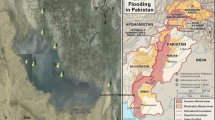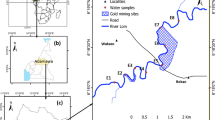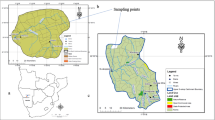Abstract
Chahnimeh reservoirs are the main drinking water sources for the big cities of Sistan and Baluchestan Province (Zabol, Zahak and Zahedan) and their water quality of may have a great influence on public health. Therefore, the aims of this study are to assess hydrogeochemical characteristics, and heavy metal(loid)s pollution in four Chahnimeh reservoirs using water quality pollution indices and principal component analysis. The concentrations of Al, As, Ba, Cd, Cr, Cu, Fe, Mn, Mo, Ni, Pb, Se, U, and Zn in 84 water samples were measured for two periods. Hydrogeochemical analyses, Piper and Gibbs diagrams, show a change in the water type from Na–HCO3 and Na–SO4 to Na–Cl, and a bit tendency of water–rock interaction to evaporation, from September 2017 to April 2018. Based on the heavy metal pollution index, heavy metal evaluation index, and contamination index, water quality of Chahnimeh reservoirs is decreased in order: reservoirs 2 > 3 > 4 > 1. The result of statistical analysis reveals that Mo content is affected by a geogenic origin, while Se and U indicate a quasi-independent behavior within the groups reflecting contribution of both geogenic and anthropogenic sources. HCO3 plays a significant role in distribution of Se and U. Also, Fe, Mn and Al oxy-hydroxides can control concentrations of Cu, Pb and Ni. Overall the obtained results indicated that the variation of water quality in the study area was related to climatic conditions, high evaporation, water–rock interaction, different land uses, drying Hamoun Lakes and anthropogenic effects in the Hirmand watershed. The current study reveals that the use of integrated methods such as statistical methods and heavy metal pollution indices to determine the water quality is very suitable.






Similar content being viewed by others
References
Afghanistan sitting on a gold mine Archived (2011) the Wayback Machine, 12–31.
Alberto, W. D., del Pilar, D. M., Valeria, A. M., Fabiana, P. S., Cecilia, H. A., & de los Ángeles, B. M. (2001). Pattern recognition techniques for the evaluation of spatial and temporal variations in water quality. A case study: Suquı́a River Basin (Córdoba–Argentina). Water Research,35(12), 2881–2894.
Asare-Donkor, N. K., Kwaansa-Ansah, E. E., Opoku, F., & Adimado, A. A. (2015). Concentrations, hydrochemistry and risk evaluation of selected heavy metals along the Jimi River and its tributaries at Obuasi a mining enclave in Ghana. Environmental Systems Research,4(1), 12.
Backman, B., Bodiš, D., Lahermo, P., Rapant, S., & Tarvainen, T. (1998). Application of a groundwater contamination index in Finland and Slovakia. Environmental Geology,36(1–2), 55–64.
Bahnasawy, M., Khidr, A. A., & Dheina, N. (2011). Assessment of heavy metal concentrations in water, plankton, and fish of Lake Manzala, Egypt. Turkish Journal of Zoology,35(2), 271–280.
Bhardwaj, R., Gupta, A., & Garg, J. K. (2017). Evaluation of heavy metal contamination using environmetrics and indexing approach for River Yamuna, Delhi stretch, India. Water Science,31(1), 52–66.
Bhuiyan, M. A., Parvez, L., Islam, M. A., Dampare, S. B., & Suzuki, S. (2010). Heavy metal pollution of coal mine-affected agricultural soils in the northern part of Bangladesh. Journal of Hazardous Materials,173(1–3), 384–392.
Corteel, C., Dini, A., & Deyhle, A. (2005). Element and isotope mobility during water–rock interaction processes. Physics and Chemistry of the Earth, Parts A/B/C,30(17–18), 993–996.
Das Sharma, S. (2019). Risk assessment and mitigation measures on the heavy metal polluted water and sediment of the Kolleru Lake in Andhra Pradesh, India. Pollution,5(1), 161–178.
Edet, A. E., & Offiong, O. E. (2002). Evaluation of water quality pollution indices for heavy metal contamination monitoring. A study case from Akpabuyo-Odukpani area, Lower Cross River Basin (southeastern Nigeria). GeoJournal,57(4), 295–304.
Egbueri, J. C. (2018). Assessment of the quality of groundwaters proximal to dumpsites in Awka and Nnewi metropolises: A comparative approach. International Journal of Energy and Water Resources,2(1–4), 33–48.
Emberger, L. (1955). Une classification biogeographique des climats. Recueil des travaux des laboratories des botanique, geologie et zoologie de la Faculte des Sciences de l’Universite de Montpellier. Serie Botanique,7, 3–45.
Fito, J., Bultossa, G., & Kloos, H. (2019). Physicochemical and heavy metal constituents of the groundwater quality in Haramaya Woreda, Oromia Regional State, Ethiopia. International Journal of Energy and Water Resources,3(1), 23–32.
Gibbs, A. J., & McIntyre, G. A. (1970). The diagram, a method for comparing sequences: Its use with amino acid and nucleotide sequences. European Journal of Biochemistry,16(1), 1–11.
González-Audícana, M., Saleta, J. L., Catalán, R. G., & García, R. (2004). Fusion of multispectral and panchromatic images using improved IHS and PCA mergers based on wavelet decomposition. IEEE Transactions on Geoscience and Remote Sensing,42(6), 1291–1299.
Hakanson, L. (1980). An ecological risk index for aquatic pollution control. A sedimentological approach. Water Research,14(8), 975–1001.
Helena, B., Pardo, R., Vega, M., Barrado, E., Fernandez, J. M., & Fernandez, L. (2000). Temporal evolution of groundwater composition in an alluvial aquifer (Pisuerga River, Spain) by principal component analysis. Water Research,34(3), 807–816.
Homayoun Neshad, I., Savari, A., Saeidpour, B., & Nouri, G. R. (2007). Investigation of water quality: A case study of Zabol Chah-Nimeh Reservoirs. Journal of Environmental Science and Technology,9, 13–21.
Kaiser, H. F. (1960). The application of electronic computers to factor analysis. Educational and Psychological Measurement,20(1), 141–151.
Klake, R. K., Nartey, V. K., Doamekpor, L. K., & Edor, K. A. (2012). Correlation between heavy metals in fish and sediment in Sakumo and Kpeshie Lagoons, Ghana. Journal of Environmental Protection,3(09), 1070.
Klavinš, M., Briede, A., Rodinov, V., Kokorite, I., Parele, E., & Klavina, I. (2000). Heavy metals in rivers of Latvia. Science of the Total Environment,262(1–2), 175–183.
Kumar, P. S., Delson, P. D., & Babu, P. T. (2012). Appraisal of heavy metals in groundwater in Chennai city using a HPI model. Bulletin of Environmental Contamination and Toxicology,89(4), 793–798.
Kumari, R., & Sharma, R. C. (2019). Assessment of water quality index and multivariate analysis of high altitude sacred lake Prashar, Himachal Pradesh, India. International Journal of Environmental Science and Technology,16(10), 6125–6134.
Loni, O. A., Zaidi, F. K., Alhumimidi, M. S., Alharbi, O. A., Hussein, M. T., Dafalla, M., et al. (2015). Evaluation of groundwater quality in an evaporation dominant arid environment; A case study from Al Asyah area in Saudi Arabia. Arabian Journal of Geosciences,8(8), 6237–6247.
Mahato, M., Singh, P., Singh, A., & Tiwari, A. (2016). Assessment of major ionic compositions and anthropogenic influences in the rainwater over a coal mining environment of Damodar River basin, India. Pollution,2(4), 461–474.
Mandal, S. K., Dutta, S. K., Pramanik, S., & Kole, R. K. (2019). Assessment of river water quality for agricultural irrigation. International Journal of Environmental Science and Technology,16(1), 451–462.
Mohan, S. V., Nithila, P., & Reddy, S. J. (1996). Estimation of heavy metals in drinking water and development of heavy metal pollution index. Journal of Environmental Science and Health Part A,31(2), 283–289.
Najafi, A., & Vatanfada, J. (2011). Environmental challenges in trans-boundary waters, case study: Hamoon Hirmand Wetland (Iran and Afghanistan). International Journal of Water Resources and Arid Environments,1(1), 16–24.
Nasrabadi, T., Bidhendi, G. N., Karbassi, A., Grathwohl, P., & Mehrdadi, N. (2011). Impact of major organophosphate pesticides used in agriculture to surface water and sediment quality (Southern Caspian Sea basin, Haraz River). Environmental Earth Sciences,63(4), 873–883.
Ndungu, J., Augustijn, D. C., Hulscher, S. J., Fulanda, B., Kitaka, N., & Mathooko, J. M. (2015). A multivariate analysis of water quality in Lake Naivasha, Kenya. Marine and Freshwater Research,66(2), 177–186.
Noori, R., Karbassi, A., Khakpour, A., Shahbazbegian, M., Badam, H. M. K., & Vesali-Naseh, M. (2012). Chemometric analysis of surface water quality data: Case study of the Gorganrud River Basin, Iran. Environmental Modeling and Assessment,17(4), 411–420.
Noori, R., Sabahi, M. S., Karbassi, A. R., Baghvand, A., & Zadeh, H. T. (2010). Multivariate statistical analysis of surface water quality based on correlations and variations in the data set. Desalination,260(1–3), 129–136.
Nowak, B. (1998). Contents and relationship of elements in human hair for a non-industrialised population in Poland. Science of the Total Environment,209(1), 59–68.
Ouyang, Y., Nkedi-Kizza, P., Wu, Q. T., Shinde, D., & Huang, C. H. (2006). Assessment of seasonal variations in surface water quality. Water Research,40(20), 3800–3810.
Pandey, J., & Singh, R. (2017). Heavy metals in sediments of Ganga River: Up- and downstream urban influences. Applied Water Science,7(4), 1669–1678.
Pejman, A. H., Bidhendi, G. N., Karbassi, A. R., Mehrdadi, N., & Bidhendi, M. E. (2009). Evaluation of spatial and seasonal variations in surface water quality using multivariate statistical techniques. International Journal of Environmental Science and Technology,6(3), 467–476.
Piper, A. M. (1944). A graphic procedure in the geochemical interpretation of water-analyses. EOS, Transactions American Geophysical Union,25(6), 914–928.
Prasad, B., & Mondal, K. K. (2008). The impact of filling an abandoned open cast mine with fly ash on ground water quality: A case study. Mine Water and the Environment,27(1), 40–45.
Prasad, B., & Sangita, K. (2008). Heavy metal pollution index of ground water of an abandoned open cast mine filled with fly ash: A case study. Mine Water and the Environment,27(4), 265–267.
Prasanna, M. V., Praveena, S. M., Chidambaram, S., Nagarajan, R., & Elayaraja, A. (2012). Evaluation of water quality pollution indices for heavy metal contamination monitoring: A case study from Curtin Lake, Miri City, East Malaysia. Environmental Earth Sciences,67(7), 1987–2001.
Qin, H. P., Su, Q., Khu, S. T., & Tang, N. (2014). Water quality changes during rapid urbanization in the Shenzhen River Catchment: An integrated view of socio-economic and infrastructure development. Sustainability,6(10), 7433–7451.
Rajaei, G., Mansouri, B., Jahantigh, H., & Hamidian, A. H. (2012). Metal concentrations in the water of Chah nimeh reservoirs in Zabol, Iran. Bulletin of environmental contamination and toxicology,89(3), 495–500.
Reza, R., & Singh, G. (2010). Heavy metal contamination and its indexing approach for river water. International Journal of Environmental Science and Technology,7(4), 785–792.
Semiromi, F. B., Hassani, A. H., Torabian, A., Karbassi, A. R., & Lotfi, F. H. (2011). Evolution of a new surface water quality index for Karoon catchment in Iran. Water Science and Technology,64(12), 2483–2491.
Singh, G., & Kamal, R. K. (2017). Heavy metal contamination and its indexing approach for groundwater of Goa mining region, India. Applied Water Science, 7(3), 1479–1485.
Singh, K. P., Malik, A., Mohan, D., & Sinha, S. (2004). Multivariate statistical techniques for the evaluation of spatial and temporal variations in water quality of Gomti River (India)—A case study. Water Research,38(18), 3980–3992.
Tao, Y., Yuan, Z., Wei, M., & Xiaona, H. (2012). Characterization of heavy metals in water and sediments in Taihu Lake, China. Environmental Monitoring and Assessment,184(7), 4367–4382.
Varol, S., & Köse, İ. (2018). Effect on human health of the arsenic pollution and hydrogeochemistry of the Yazır Lake wetland (Çavdır-Burdur/Turkey). Environmental Science and Pollution Research,25(16), 16217–16235.
Vekerdy, Z., Dost, R. J. J., Reinink, G., & Partow, H. (2006). History of environmental change in the Sistan Basin based on satellite image analysis: 1976–2005. Geneva: United Nations Environment Programme.
Vu, C. T., Lin, C., Shern, C. C., Yeh, G., & Tran, H. T. (2017). Contamination, ecological risk and source apportionment of heavy metals in sediments and water of a contaminated river in Taiwan. Ecological Indicators,82, 32–42.
Wasike, P. W., Nawiri, M. P., & Wanyonyi, A. A. (2019). Levels of heavy metals (Pb, Mn, Cu and Cd) in water from River Kuywa and the adjacent wells. Environment and Ecology Research,7(3), 135–138.
WHO (World Health Organization). (2011). Guidelines for drinking-water quality. Edition, F.,38(4), 104–108.
Wu, Z., Wang, X., Chen, Y., Cai, Y., & Deng, J. (2018). Assessing river water quality using water quality index in Lake Taihu Basin, China. Science of the Total Environment,612, 914–922.
Zaidi, F. K., Nazzal, Y., Jafri, M. K., Naeem, M., & Ahmed, I. (2015). Reverse ion exchange as a major process controlling the groundwater chemistry in an arid environment: A case study from northwestern Saudi Arabia. Environmental Monitoring and Assessment,187(10), 607.
Zelano, I., Malandrino, M., Giacomino, A., Buoso, S., Conca, E., Sivry, Y., et al. (2017). Element variability in lacustrine systems of Terra Nova Bay (Antarctica) and concentration evolution in surface waters. Chemosphere,180, 343–355.
Zhang, Z., Wang, J. J., Ali, A., & DeLaune, R. D. (2016). Heavy metals and metalloid contamination in Louisiana Lake Pontchartrain Estuary along I-10 Bridge. Transportation Research Part D: Transport and Environment,44, 66–77.
Acknowledgements
The authors wish to express their gratitude to Kharazmi University for financial support and Sistan and Baluchestan regional water company of Iran for logistic assistance. Thanks are extended to Ms. Estelle Toerien for English editing of the article.
Author information
Authors and Affiliations
Corresponding author
Rights and permissions
About this article
Cite this article
Hosseini, H., Shakeri, A., Rezaei, M. et al. Water chemistry and water quality pollution indices of heavy metals: a case study of Chahnimeh Water Reservoirs, Southeast of Iran. Int J Energ Water Res 4, 63–79 (2020). https://doi.org/10.1007/s42108-019-00051-7
Received:
Accepted:
Published:
Issue Date:
DOI: https://doi.org/10.1007/s42108-019-00051-7




